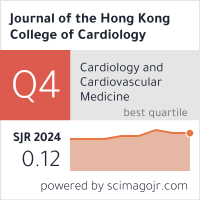Abstract
Background: SARS is a new infection in humans with unknown medium or long-term complication. Palpitation in the form of tachycardia is common amongst patients recovering from SARS. We studied the extent and possible cause of tachycardia in these patients. Methods: Prospective cross-sectional case series of patients treated in Princess Margaret Hospital in Hong Kong recovering from SARS who had resting heart rate of more than 90 beats per minute (BPM) at follow up about 2 months from onset of illness was recruited for assessment of heart rate and rhythm, cardiac function, pulmonary function, laboratory tests, Quality of Life score and Functional assessment. Patients were followed up in the out-patient clinic for at least 1 year after discharge. Results: Fifteen out of 100 consecutive patients were eligible for study. Median mean heart rate was 82 BPM (range 70-91) with maximum heart rate ranging from 114 to 163 BPM. Sinus tachycardia was recorded only in daytime. Signal average ECG, heart rate variability, and echocardiography were normal. Two patients had significantly impaired spirometic indices while all but one had normal diffusion capacity study. Mean haemoglobin level was 13.4 gm/l (10.6-14.9). Troponin I, thyroid function, arterial blood gases, C reactive protein and liver function tests were normal. Quality of Life (QOL) score was low especially in the psychological well being domain. Monitored Functional Task Evaluation (MFTE) score demonstrated mild functional difficulties in 10 patients (score17.6-19.7). No symptom of palpitation was present at follow up after 1 year. Conclusion: No significant arrhythmia or cardiac abnormality was identified. Sinus tachycardia on exertion in patients recovering from SARS is possibly attributed to physical deconditioning and contributed by psychological impairment.
Recommended Citation
Suet-Ting Lau, Wai-Cho Yu, Ngai-Shing Mok, Ping-Tim Tsui, Tachycardia Amongst Subjects Recovering from Severe Acute Respiratory Syndrome (SARS): A Prospective Case Study Journal of the Hong Kong College of Cardiology 2005;13(2) https://doi.org/10.55503/2790-6744.1125
Creative Commons License

This work is licensed under a Creative Commons Attribution-Noncommercial-No Derivative Works 4.0 License.



